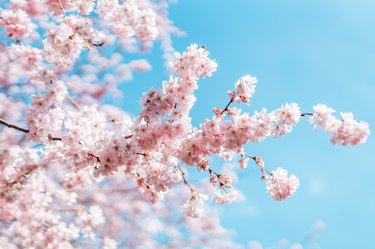
Cherry trees (Prunus spp.) are among the flowering and fruiting tree species that produce flowers before the leaves appear. Cherry tree blossoms are notable for the clouds of white, blushed or pink flowers that appear in spring. The trees are hardy in U.S. Department of Agriculture plant hardiness zones 4 through 10 depending on the species and cultivar.
Whether it's a fruiting or flowering cherry tree species, once the tree begins producing flowers, the blossoms generally appear first. In some cases, the leaves may bud out at the same time as the flowers.
Video of the Day
Video of the Day
Flowering Cherry Trees
The flowering cherry species and hybrids vary in their form and flowers. Trees may be upright and spreading, rounded or weeping. They may produce single or double white, blushed or pink blossoms. Many of the cultivated flowering cherry trees produce very few or no fruits.
The Japanese flowering cherry (Prunus serrulata) generally grows up to 25 feet tall and equally wide in USDA zones 5 through 9. The cultivar Kwanzan (Prunus serrulata 'Kwanzan') is one of several flowering cherries planted in Washington, D.C. Its unscented, double pink flowers appear after the white clouds of Yoshino cherry blossoms (Prunus x yedoensis 'Yoshino') and single pale pink flowers of the Akebono cherry trees (Prunus x yedoensis 'Akebono'), both hardy in USDA zones 5 through 8.
In addition to the many other flowering cherries grown in and around Washington, D.C., of particular interest are the Usuzumi cherries (Prunus spachiana f. ascendens 'Usuzumi'), which produce single white blossoms on up to 40-foot-tall trees. Hardy in USDA zones 6 through 8, the Usuzumi trees planted in West Potomac Park were propagated from the famous 1,400-year-old Usuzumi tree that is revered in Japan.
Sour Cherry Trees
Sour cherries (Prunus cerasus), also known as pie or tart cherries, thrive in USDA zones 4 through 7 depending on the cultivar. Like the flowering cherries, the white flowers of the sour cherry trees generally appear before the leaves. Among the best known of the P. cerasus cultivars are Early Richmond, Meteor, Montmorency and North Star. These tart cherries are best used for jams, jellies and pies.
Sweet Cherry Trees
Sweet cherry trees (Prunus avium), hardy in USDA zones 5 through 8, produce white or pink flowers on up to 30-foot-tall standard trees. Unlike sour cherries, which are self-fertile, most sweet cherry cultivars require a second compatible tree that blooms at the same time to ensure a good harvest.
Sweet cherry fruits are generally yellow, yellow blushed with pink or red, bright red, dark red, purplish-red or nearly black. Among the best-known P. avium cultivars are Bing, Black Tartarian, Lapin, Rainier, Royal Ann and Stella. In addition, newer P. avium cultivars that thrive in USDA zones 8 through 10 include Minnie Royal and Royal Lee. Sweet cherries are enjoyed fresh and in desserts.
Cherry Blossoms and Winter Weather
Depending on the species and cultivar, fruiting cherry trees generally need between 700 and 1,200 hours of uninterrupted winter temperatures between 32 and 45 degrees Fahrenheit. Without those chilling hours, the trees won't break dormancy to produce flowers and fruit. Even the leaves will be delayed, and if the tree does produce a few blossoms, it is unlikely to produce the high-quality fruit that you usually harvest from that tree. A few "low-chill" cultivars, such as Lapin, Stella, Montmorency and North Star, only need 400 to 500 chill hours, while Minnie Royal and Royal Lee only need 200 to 300 chill hours.
Of greater concern are harsh winters and late frosts. In midwinter, several days of weather below -15 degrees or a period of warm weather followed by a quick drop back to cold winter temperatures can damage the cherry tree flower buds so badly that the blossoms will never open. In addition, a late frost just as the flowers are opening not only results in severe damage and bud drop but prevents honeybees and native bees from leaving their burrows and hives to pollinate the blossoms.
- Clemson Cooperative Extension: Ornamental Cherry, Plum, Apricot and Almond
- National Park Service: Cherry Blossom Festival: Cherry Tree Types & Locations
- Harvest to Table: Sour Cherry Varieties
- Harvest to Table: Sweet Cherry Varieties
- PennState Extension: Home Orchards: Why Is There No Fruit on My Tree?